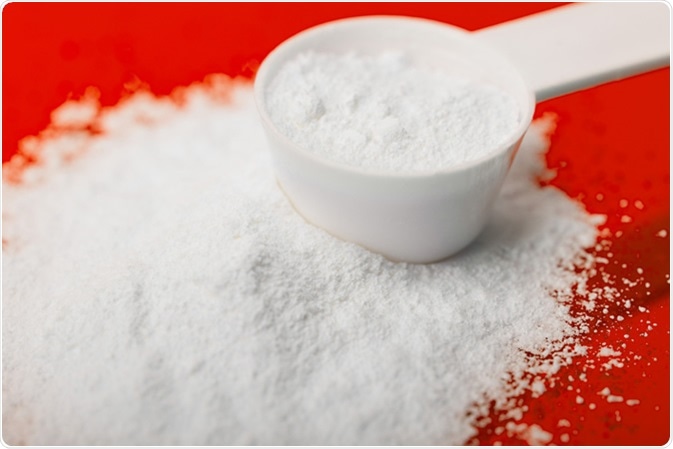What is Creatine?
Skip to
- How is creatine made?
- What does creatine do?
- Creatine Supplements
- Possible side effects
Creatine (methylguanidine acetic acid) is a naturally occurring molecule derived from amino acids that is primarily stored in skeletal muscle. Creatinine is also found in the liver, pancreas, testes and kidneys, although in much smaller quantities.
Once combined with phosphate to form phosphocreatine or creatine phosphate, it serves as a readily available source of energy. It is typically stored at a concentration of 100-150 mmol/kg dry weight of muscle in both free and phosphorylated forms.
Creatine is also found in food sources of protein, including milk, red meat and some seafoods, but it can also be made synthetically and is commonly sold as dietary supplement. The average intake of creatine from nutritional sources in humans is approximately one gram per day.
People often take oral creatine supplements to increase muscle mass, reduce muscle fatigue and to enhance physical or athletic performance. Studies indicate that creatine can increase performance during short bursts of intense exercise with a short maximal effort such as sprinting or bench pressing. It does not confer any endurance benefit in aerobic exercise.
Some researchers speculate that creatine supplementation may improve mental performance and help to treat heart failure and aging skin.

How is creatine made?
Creatinine is mainly synthesized in the liver. The enzyme glycine transaminidase transfers an amidine group from arginine to glycine, to give guanidinoacetic acid. This acid is then methylated by the enzyme guanidinoacetate methyltransferase to form creatine.
The creatine is then carried via in the circulatory system to storage sites, 95% of which are in the skeletal muscle. There, about 60 to 70% of the creatinine is phosphorylated by adenosine triphosphate to form phosphocreatine, which stops the molecule from being transported across the plasma membrane and contains it within the muscle cell. When creatine is ingested via the diet, it is carried from the intestine to the appropriate storage sites.
What does creatine do?
Creatine is used as a basic energy source in muscles, particularly by fast twitch skeletal fibers. The muscles use ATP during exercise and the by-product is adenosine diphosphate (ADP). Creatine helps to replenish ATP, as the phosphorylated form provides an immediate source of high-energy phosphate groups that are picked up by ADP to reform ATP, thereby serving as a buffer that maintains ATP production.
Since phosphocreatine is made through conversion of creatine by ATP in the first place, a shortage of ATP will slow the synthesis of phosphocreatine. During vigorous-intensity exercise, the ATP:ADP dramatically decreases as the high-energy phosphate groups from ATP are used up. This can result in muscle failure during short bursts of intense anaerobic exercise such as strength training. However, creatine phosphorylates ADP and converts it back to ATP. It is therefore crucial for sustaining an ATP:ADP ratio that will delay muscle fatigue and extend the length of time that high-intensity exercise can be carried out.
Creatine Supplements
Many people who weight train would probably agree that creatine is one of the most popular nutritional supplements that enthusiasts can take. The product is sold in nutrition stores, sports shops and even grocery stores and many manufacturers ensure the product is available in various forms including liquids, powders, and capsules.
Some research into the effect that oral creatine supplementation has on exercise suggests it significantly increases the level of phosphocreatine in fast-twitch glycolytic fibers. Many researchers agree that it increases the amount of work that can be done in trials of short duration, maximum effort exercise.
No standard dosing or duration regimens for oral creatine supplementation have been universally agreed on, but many athletes tend to use them for a few months at a time, separated by a month in-between. The best way to use the supplements is to take them immediately following exercise and in combination with a high-glycemic index drink.
Research into the effects of oral creatine supplementation among children with rare creatine-metabolizing syndromes suggests that children with creatine deficiency may experience some improvement in symptoms.
Currently, there is not yet enough evidence to support the use of creatine supplementation as a treatment for heart failure. Preliminary studies into its impact on skin aging suggest that daily application of a creatine-containing cream for six weeks may reduce skin wrinkling among men. Another study indicated that a cream containing creatine and folic acid may improve sun damaged or wrinkled skin.
People with low creatine levels such as those who follow a vegan or vegetarian diet may also benefit from taking the supplements.
Some research has provided evidence that an increase in the phosphocreatine energy buffer as a result of creatine administration may confer protective effects in neurodegenerative disease. In a mouse model of spinocerebellar ataxia type 3, creatine supplementation recovered motor balance and coordination, as well as restoring brain weight and mitigating astrogliosis (an abnormal increase in astrocyte number).
Possible side effects
Creatine supplements may lead to weight gain, a high level of creatine in the urine and/or blood and kidney dysfunction. Creatine supplements should not be taken by people with a history of kidney dysfunction. Less common side effects include stomach upset, dehydration and muscle cramps.
Sources
- https://nccih.nih.gov/health/creatine
- https://www.sciencedirect.com/topics/neuroscience/creatine
- www.umich.edu/…/creatinebasicsandbiochemistry101705.html
- ttps://www.mayoclinic.org/drugs-supplements-creatine/art-20347591
- www.msdmanuals.com/…/creatine
- https://www.britannica.com/science/creatine
- http://muscle.ucsd.edu/musintro/creatine.shtml
- https://onlinelibrary.wiley.com/doi/abs/10.1002/mds.27292
Further Reading
- All Creatine Content
- Creatine Supplements
- Creatine Research
Last Updated: Sep 15, 2019

Written by
Sally Robertson
Sally has a Bachelor's Degree in Biomedical Sciences (B.Sc.). She is a specialist in reviewing and summarising the latest findings across all areas of medicine covered in major, high-impact, world-leading international medical journals, international press conferences and bulletins from governmental agencies and regulatory bodies. At News-Medical, Sally generates daily news features, life science articles and interview coverage.
Source: Read Full Article
